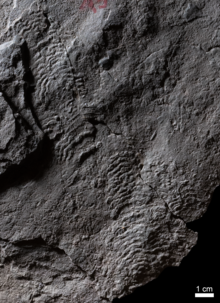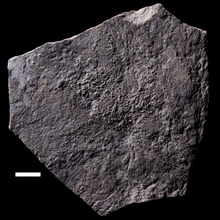
A "Palaeopascichnid" describes a multitude of elongate fossils made up of multiple sausage-shaped chambers. They appear only in Ediacaran sediments. Fossils of Palaeopascichnids consist of an occasionally branching series of globular or elongate chambers. These fossils started appearing in the Vendian (late Ediacaran) about 580 million years ago. Fossils of Palaeopascichnids are found in East European platform (White Sea, Urals, Moscow syneclise, Podolia, Finnmark), Siberia (Olenyok uplift, Uchur-Maya basin), South China (Lantian), Australia (Flinders Ranges), India (Tethys), Avalonia (Charnwood, Newfoundland), Romania (Histria Formation)
Palaeopascichnid fossils are believed to be the first ever macroorganisms that show signs of an agglutinated skeleton.

Genera
Genera currently considered to belong to the group include:
- Genus Palaeopascichnus Palij, 1976
- P. delicatus Palij, 1976
- P. linearis Fedonkin, 1976
- P. gracilis Fedonkin, 1985
- Genus Orbisiana Sokolov, 1976
- O. simplex Sokolov, 1976
- O. intorta Kolesnikov & Desiatkin, 2022
- O. spumea Kolesnikov & Desiatkin, 2022

See also
References
- ^ Kolesnikov, A. V. (2019). "Stratigraphic correlation potential of the Ediacaran palaeopascichnids". Estudios Geológicos. 75 (2): 102. doi:10.3989/egeol.43588.557. S2CID 210269249.
- Grazhdankin, Dmitriy (2014). "Patterns of Evolution of the Ediacaran Soft-Bodied Biota". Journal of Paleontology. 88 (2): 269–283. doi:10.1666/13-072. S2CID 129317326.
- Fedonkin, M. A. (1981). Keller, B. M. (ed.). "White Sea biota of Vendian: Precambrian non-skeletal fauna in the Russian Platform North". Transactions of the Geological Institute. 342. Moscow: Nauka: 1–100.
- Becker, Yu.R. & Kishka, N.V. (1989). "Открытие эдиакарской биоты на Южном Урале" [The discovery of Ediacaran biota in the Southern Urals]. In T.N. Bogdanova & L.I. Khozatsky (ed.). Теоретические и прикладные аспекты современной палеонтологии. Тезисы докладов XXXIII сессии. Всесоюзного палеонтологического общества [Theoretical and applied aspects of modern paleontology. Proceedings of the XXXIII session of the All-Union Paleontological Society.] (PDF) (in Russian). Leningrad: Nauka. pp. 109–120. Archived from the original (PDF) on 2019-08-08. Retrieved 2019-08-08.
{{cite book}}: CS1 maint: multiple names: authors list (link) - Palij, V.M. (1976). "Ostatki besskeletnoy fauny i sledy zhiznedeyatel'nosti iz otlozheniy verkhnego dokembriya i nizhnego kembriya Podolii" [Remains of the diskeletal fauna and traces of life activity from the deposits of the Upper Precambrian and the lower Cambrian of Podilia]. Paleontologiya i stratigrafiya verkhnego dokembriya i nizhnego paleozoya yugo-zapada Vostochno-Yevropeyskoy platformy [Paleontology and Stratigraphy of the Upper Precambrian and the Lower Paleozoic of the Southwest of the Eastern European Platform] (in Russian). Kiev: Naukova Dumka. pp. 63–77.
- Högström, AES; Jensen, S; Palacios, T; Ebbestad, JOR (2013). "New information on the Ediacaran-Cambrian transition in the Vesteranda Group, Finnmark, northern Norway, from trace fossils and organic-walled microfossils". Norwegian Journal of Geology. 93: 95–106.
- Ivantsov, A. Yu. (2017). "Finds of Ediacaran-type fossils in Vendian deposits of the Yudoma Group, eastern Siberia". Doklady Earth Sciences. 472 (2): 143–146. Bibcode:2017DokES.472..143I. doi:10.1134/S1028334X17020131. S2CID 131900154.
- Yan, Y.; Jiang, C.; Zhang, S.; Du, S.; and Bi, Z. (1992). "Research of the Sinian System in the region of western Zhejiang, northern Jiangxi, and southern Anhui provinces". Bull. Nanjing Inst. Geol. Mineral Res. Supplementary Issue 12. Chinese Acad. Geol. Sci.: 1–105.
{{cite journal}}: CS1 maint: multiple names: authors list (link) - Glaessner, M. F. (1969). "Trace fossils from the Precambrian and basal Cambrian". Lethaia. 2 (4): 369–393. doi:10.1111/j.1502-3931.1969.tb01258.x.
- Parcha, S. K.; Pandey, S. (2011). "Ichnofossils and their significance in the Cambrian succession of the Parahio Valley in the Spiti Basin, Tethys Himalaya, India". Journal of Asian Earth Sciences. 42 (6): 1097–1116. Bibcode:2011JAESc..42.1097P. doi:10.1016/j.jseaes.2011.04.028.
- Cope, JCW (1982). "Precambrian fossils of the Carmarthen area, Dyfed". Nature in Wales. 1: 11–16.
- Hawco, JB; Kenchigton, CG; McIlroy, D (2021). "A quantitative and statistical discrimination of morphotaxa within the Ediacaran genus Palaeopascichnus". Papers in Palaeontology. 7 (2): 657–73. doi:10.1002/spp2.1290. S2CID 213601701.
- Saint Martin, J.-P.; Charbonnier, S.; Saint Martin, S.; Cazes, L.; André, J.-P. (2025). "New records of Palaeopaschichnus Palij, 1976 from the Ediacaran of Romania". Geodiversitas. 47 (1): 1–16. doi:10.5252/geodiversitas2025v47a1.
- Kolesnikov, A. V.; Desiatkin, V. D. (2022). "Taxonomy and palaeoenvironmental distribution of palaeopascichnids". Geological Magazine. 159 (7). Cambridge University Press: 1175–1191. Bibcode:2022GeoM..159.1175K. doi:10.1017/S0016756822000437. S2CID 249661878.
This Ediacaran biota-related article is a stub. You can help Misplaced Pages by expanding it. |